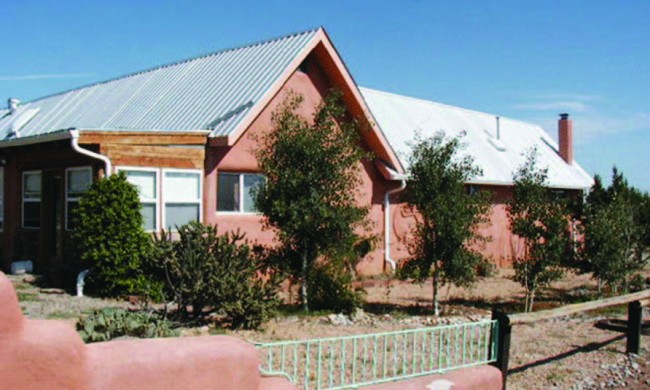The PermaDesign Weblog, with Nate Downey and Melissa McDonald!
Roof-Reliant Landscaping™ Step 15C: Water Collection - Roof Materials (Pitched Roofs)
Pitched roofs are constructed using a wide variety of materials, including metal, tile, shingle, slate and treated wood. From a water harvesting perspective, metal is the preferred pitched roof material because of its high runoff coefficient and because other more-porous roof materials can leach toxins into your cistern and, ultimately, to the root zones of your plants.
Metal. A pitched, sheet metal roof is the cleanest and most efficient collection surface available. It provides a smooth surface that conveys water efficiently. Sheet metal is competitively priced throughout much of New Mexico and lasts a long time under normal conditions. Metal tile is also available, but it is more expensive and less efficient at collecting water. Metal is a relatively durable and longlasting roof material, and it is priced in the mid-range for roof materials. (See Figure 7-1.)
Asphalt. Asphalt roofs are popular because they are made from some of the least expensive roofing materials available. Asphalt shingles are typically made of either a paperbased or a fiberglass-based mesh soaked in asphalt. Due to the leaching that can occur from asphalt shingles, this is a poor roof choice from a water quality perspective.

Clay. In some parts of the world, clay tile roofs are the dominant roofing material. Although clay makes a great material for water harvesting due to its smoothness, clay tile is not especially popular in New Mexico because it is usually more expensive than metal roofing and the tiles need to be replaced more often because they crack easily in our freeze-thaw climate.
Slate. Slate is a very smooth and exceptionally durable surface, which makes it excellent for water harvesting. However, slate roofs are not common in New Mexico because slate is expensive to import from the few eastern states that quarry it. Slate typically comes in small rectangular tiles (also called shingles), but it is a relatively heavy material, which further increases the high cost of shipping.
Concrete. Concrete tile can be a good roof choice in New Mexico due to its ability to insulate the building it covers. A small portion of each storm’s water will be absorbed due to the natural porosity of concrete; however, this water, which ultimately evaporates, is usually not a significant quantity. Concrete roofing is noncombustible and can be a good alternative to other materials in fire-prone areas.
Fiberglass. Laminated fiberglass shingles contain the same materials as some asphalt shingles, but they last up to twice as long as regular asphalt shingles. The potential leaching of asphalt and fiberglass make this a poor choice from a water harvesting perspective. In addition, fiberglass roofing is fairly costly.
Glass and polycarbonate sheets. Sunrooms, greenhouses and solariums are some of the typical places where you will find both glass and polycarbonate roofing. Due to their extremely smooth quality, glass, polycarbonate sheets and other types of glazing are often among the most efficient surfaces available for harvesting precipitation.
Wood. Wood roofs are usually built using shingles made either of a hard wood that contains a natural resistance to rot or of wood that has been treated with a rot-resistant chemical. They are often very attractive, usually relatively expensive and typically the most flammable of standard roofing materials found in New Mexico. Wood roofs are neither the most efficient nor the most inefficient of water collection surfaces.
Asbestos. Due to its toxicity, it is wise to avoid materials that contain asbestos when designing your cistern system. Fortunately, asbestos use in building materials has declined significantly since 1980, but trace amounts can still be found in some asphalt shingles, asphalt roofing felt, cement roofing shingles and wood shingle vapor retardants. Keep in mind that serious health-related problems often occur during the removal of asbestos, so licensed professionals need to be hired when removing a roof containing asbestos.
01/17/2016 | (0) Comments










Comments